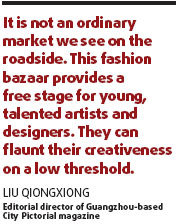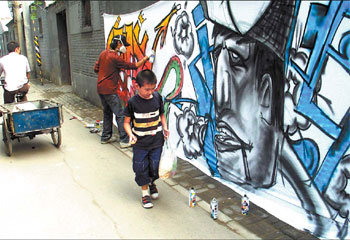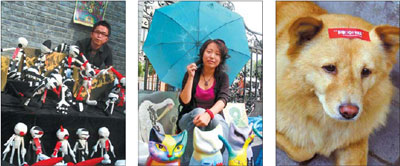This little panda went to market
|
A graffiti artist from the Beijing-based Jiumen Studio works on a mural. Photos by Jiang Don |
You can tell Hong Qi's love of giant pandas from her hand-made goods proudly displayed on her little stall in Beijing's famous Nanluoguxiang Hutong. Canvas bags, badges of different sizes, pottery hangings and cups all featured her comic design of a panda with two enormous eyes and a hilarious expression.
Hong juggled a panda bell-ring rattle in her left hand and in her right, a fluffy, adorable giant panda hat, a souvenir she bought in Britain. Passers-by stopped, tried on the hat, shook the rattle and took photos. Many look disappointed learning that neither was for sale. The products can only be bought on Hong's website.
"I like the giant panda, and I love black and white. The 'Panda Queen' is my incarnation," says Hong, a Beijing-based professional photographer, illustrator and painter.
Her "Panda Queen" products are sold online but her simple marketing campaign has taken to the streets. Hong is one of many artists who have joined in the creative cultural industry gathered at one of Beijing's ancient streets.
The narrow and sometimes quiet Nanluoguxiang was recently crammed with an influx of handicraft booths selling original works, such as dolls, notebooks and metal ornaments. The market was named iMart. Among the stalls, there was still traditional Beijing folk crafts, such as colored paper pinwheels and blown sugar figurines.
Residents in the siheyuan courtyards, hidden in many hutong, joined the hustling crowd of visitors from home and abroad enjoying the new style market, which was making good vibrations.
A South Korean percussion band in traditional attire performed outside a Korean restaurant. Not far away, two musicians were singing and playing guitar by a bar's window.
At the other end of the alley, the air was even more heated. Following a short performance of rural yangge folk dance, several rock'n'roll bands took turns on an open-air stage. "The iMart has two meanings - art and ideas," says Liu Qiongxiong, editorial director of Guangzhou-based City Pictorial magazine, which initiated the unique market.

"It is not an ordinary market we see on the roadside. This fashion bazaar provides a free stage for young, talented artists and designers. They can flaunt their creativeness on a low threshold," Liu says.
Liu says the iMart idea was inspired by Fashion Market, a well-received book series written by Yi-Ying Wang, a girl from Taiwan who studies in Britain. She wrote about the exciting London market scene and interviewed many young artists who were trying to launch their creative businesses.
The first Chinese iMart was held in Guangzhou in 2006 during an art and design expo. It then spread to other cities such as Shanghai, Hangzhou and Xiamen.
The market finally came to the capital last October. It was held four times before organizers fixed their eyes on Nanluoguxiang.
The 786-meter-long alley, with a history of nearly 800 years, is hailed as the living fossil of the city layout of ancient Beijing.
It has 16 well preserved hutong of Yuan Dynasty (1206-1368). It also boasts an artistic mood because several art schools and institutions are located here, including the prestigious Central Academy of Drama.
It has also become modern and fashionable in recent years as bars, cafes, restaurants and small handicraft shops have settled down.
"Nanluoguxiang is unique compared to other alley-turned bar areas in Beijing. It is neither too commercial nor over-bustling. Many business owners share a commitment to maintaining the peaceful life pace here," Liu says.
Organizers want to examine how the old tradition interacts with the thriving street culture promoted by an enlarged group of young designers.
They arranged a pilot market in August by consigning products in the shops and restaurants. It turned out a success. This month's bazaar is a cooperation between City Pictorial and the grassroot Nanluoguxiang Commercial Association. They wish to develop the iMart into a monthly event.
Liu believes the tie with the local union can vitalize the historical hutong culture without ruining its antique look.
He says that about 60 percent of the market participants run the 70-odd stalls. Most of them are working in designing and advertising circles. Many come to the bazaar not just doing it for fun, but to implement their ideas.
At the stall named Nine Cats, Xing Jun displays several colored glass-ceramic models and vibrant oil paintings - all of cats.
"I love cats, and nine means the most (in Chinese culture). Cats are ingenious and independent. They are elves of the night," she says.
|
Far left: A booth selling mummy dolls. Middle: Xing Jun and her cat sculptures. Left: A dog bearing a trademark, "Chen Xing Fu", on its head, which is a Beijing-based brand of handmade dolls. |
"Stall owners exchange products with each other. I've made new friends. We are not only seeking recognition here but also inspiration for our future creations.
"The location is fantastic. I was born and grow up in Beijing. But I have never lived in a hutong. I always liked cycling through hutong on my way to school. I feel strongly attached to the atmosphere of life there," she adds.
Xia Luo's booth, People Selling Poems, is a quiet corner facing an old wall, surrounded by clusters of bamboos. She has printed her 60-odd poems on small cards and pieces of A4 paper (with a seal of her name). She charges only 1 yuan for each piece. She has also painted her poems on canvas to attract more attention. "Few people today still like poems. I hope passers-by can sit down, read the poems and feel something," she says.
There are also others who see the market as a starting point for their future career.
Cen Xin's +D Team only sells a cat-shaped pillow and a tissue box with an extra pen rack. She says the cat-shaped curving pillow is more comfortable than the normal square one.
Cen's team consists of five members and they plan to open a studio of their own. Their current material supplier and manufacturer are in Guangzhou, capital of South China's Guangdong Province. They are seeking local long-term partners, particularly in marketing, so that they can focus on designing.
Most stall owners can only make both ends meet if their goods are well received.
Pian Lijuan from East China's Fujian Province sold half her supply of hand-printed shoes, but she says it barely paid for her train tickets and accommodation. Pian says she is there to promote her brand, Liuhuang Feizao (colored glazed soap). "We also have iMart back home. But Beijing can provide us with more commercial opportunities," she says.
"We invest a lot of course, the quality material and the time we need to come up with a good idea," says Hong Qi, declining to reveal the exact cost.
"It is a market of ideas. Flaunting our great ideas comes first before making money."
(China Daily 09/25/2007 page18)
















